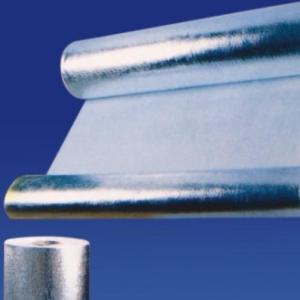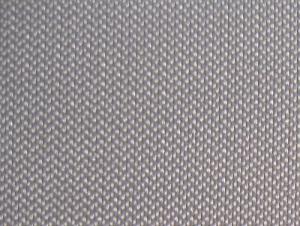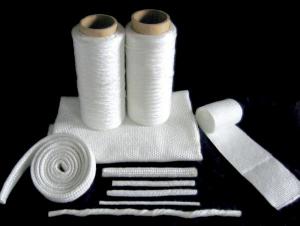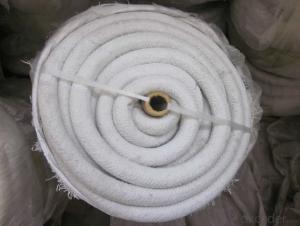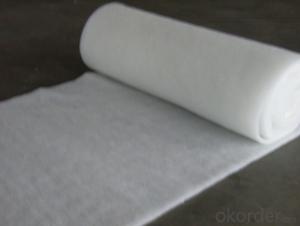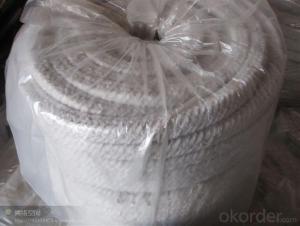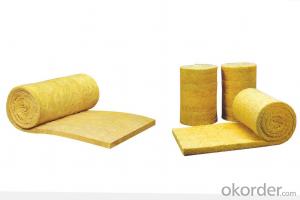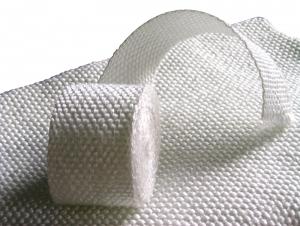E- Glass Fiber Fabric Laminated with Aluminum Foil
- Loading Port:
- China Main Port
- Payment Terms:
- TT or L/C
- Min Order Qty:
- 5t kg
- Supply Capability:
- 2*20FCL Per Month kg/month
OKorder Service Pledge
OKorder Financial Service
You Might Also Like
Basic Info of E- Glass Fiber Fabric Laminated with Aluminum Foil
Dimension/Size
1). Roll width: 48mm, 58mm
2). Roll Length: 28m,
3). Core I. D.: 3"(76mm+/-1)
Packing:Regular Package
Standard:1000m*50m
Origin:China
Product Desciption
E- Glass Fiber Fabric Laminated with Aluminum Foil was made from aluminium Foil combine Fiberglass Mesh Fabric with polyethylene. As a hot stamping foil, It is used to intalled to ceiling by heat, Insulation Batts, Radiant Barriers, Covering Ducts and Pipes.
1. Intended to supply reflection but with lighter weight
Alumium Foil + Fiberglass Mesh Fabric + PE---thermal/heat/themol sensitive adhesive sheeting/facings/finish
2. Construction & Benefits:
Details of structure was list in table.
With fiberglass mesh cloth (25mesh, 31g/sqm ) as lining made this product light but strong enough.
Apply high reflective foil as exposed face, 18mircon thick supply stronger tensile strength.
Application of E- Glass Fiber Fabric Laminated with Aluminum Foil:
Widely used in wall/floor surface reinforcement in the building preventing from wall cracks and ceiling cracks and also barrier moisture / vapor / radiant / light in cover of roof, wall, pipe, air duct, glasswool, glass fiber mat as son on.
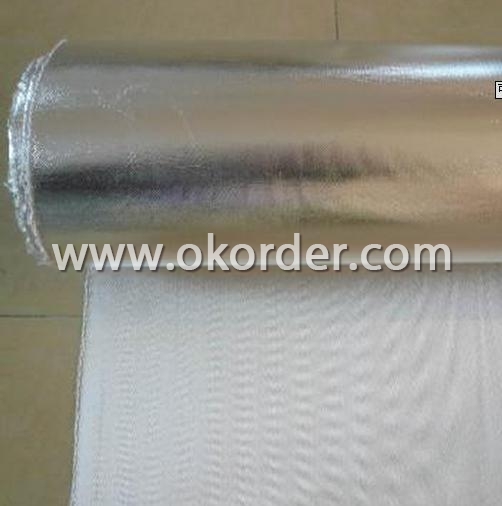
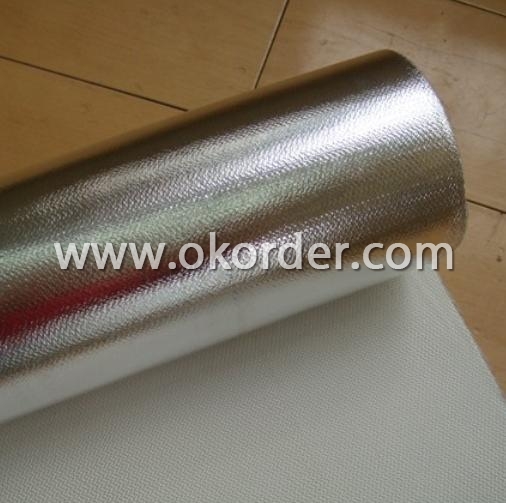
- Q:Can glass fiber textiles be used in reinforcement of natural yarns?
- Yes, glass fiber textiles can be used in the reinforcement of natural yarns. Glass fiber textiles have high tensile strength and can enhance the strength and durability of natural yarns when combined together. This combination can result in a stronger and more resilient textile material.
- Q:How do glass fiber textiles contribute to the strength of composite materials?
- Glass fiber textiles contribute to the strength of composite materials by providing reinforcement. The fibers are strong and rigid, which enhances the overall mechanical properties of the composite. They distribute the stress and load across the material, preventing cracks and increasing resistance to deformation. Additionally, the fibers are lightweight, which improves the strength-to-weight ratio of the composite, making it ideal for various applications.
- Q:How do glass fiber textiles affect recycling processes?
- Glass fiber textiles can have a negative impact on recycling processes due to their high resistance to degradation. The presence of glass fibers can make it difficult to separate and sort different materials during the recycling process, which can decrease the efficiency and effectiveness of recycling efforts. Additionally, the strong and durable nature of glass fibers can also reduce the quality of recycled materials, making them less suitable for reuse in certain applications. Therefore, glass fiber textiles present challenges and limitations in recycling processes.
- Q:How does the fiber length affect the properties of glass fiber textiles?
- The properties of glass fiber textiles are impacted by the length of their fibers. To begin with, longer fiber lengths generally result in stronger and more durable textiles. This is because the longer fibers interlock and bond within the fabric, increasing its tensile strength and making it more resistant to tearing or breaking when under stress. Additionally, longer fibers provide better flexibility and improved drapability to the fabric. They can be woven or knitted into complex patterns with greater ease, allowing the textile to be shaped and molded as required. This is especially important for applications where the fabric needs to conform to different shapes or be used in structural components. Moreover, longer fiber lengths enhance the thermal and electrical conductivity of glass fiber textiles. They provide a larger surface area for heat or electricity to transfer through the fabric. This is advantageous in applications where thermal insulation or electrical conductivity is necessary. However, it is important to consider the limitations of longer fiber lengths. They can make the textile stiffer and less comfortable to wear, reducing its suitability for clothing or soft furnishings. The longer fibers can also increase the weight of the fabric, making it less suitable for lightweight or high-performance applications. In conclusion, the choice of fiber length is crucial in determining the strength, durability, flexibility, thermal conductivity, and electrical conductivity of glass fiber textiles. It should be carefully considered based on the desired properties and specific requirements of the application.
- Q:I am producing 04 cloth of glass fiber. I want to know how to sell it
- The fabric properties are determined by fiber properties, warp and weft density, yarn structure and texture. The warp and weft density is determined by yarn structure and texture. Jingwei mithcah yarn structure, determines the physical properties of fabrics, such as weight, thickness and breaking strength.
- Q:Are glass fiber textiles resistant to solvents?
- Glass fiber textiles are known for their resistance to solvents. They possess a natural ability to remain unaffected by solvents, as they do not dissolve or deteriorate upon contact. This quality makes them highly suitable for industries involving solvents, like chemical processing and automotive manufacturing. Nevertheless, it is worth noting that the level of resistance may vary depending on the specific solvent and duration of exposure. Therefore, it is prudent to refer to the manufacturer's specifications or perform compatibility testing prior to utilizing glass fiber textiles in environments abundant in solvents.
- Q:What are the properties of glass fiber textile?
- Glass fiber textiles are lightweight, durable, and have high tensile strength. They are also resistant to heat, moisture, chemicals, and UV radiation. Additionally, glass fiber textiles provide excellent insulation and are non-flammable, making them suitable for various applications such as reinforcement in composite materials, insulation in buildings, and as a protective layer in electronics.
- Q:Can glass fiber textile be used in battery technology?
- Yes, glass fiber textile can be used in battery technology. It is often used as a component in battery separators, which help to improve the performance and safety of batteries by preventing short circuits and enhancing the flow of ions between electrodes.
- Q:Can glass fiber textiles be used in the production of furniture?
- Furniture production can make use of glass fiber textiles, which are also referred to as fiberglass textiles. These textiles are crafted by weaving together fine strands of glass fibers, resulting in a fabric known for its robustness, longevity, and ability to withstand heat, chemicals, and pests. When it comes to furniture production, glass fiber textiles can be utilized in diverse ways. They serve as reinforcement materials, imparting additional strength and stability to furniture structures. For instance, chairs, sofas, or tables can have their frames reinforced with glass fiber textiles, rendering them more resistant to bending or breakage. Moreover, glass fiber textiles can be employed as upholstery materials. By weaving or knitting them together, a fabric is created, which can then be used to cover furniture surfaces. This not only imparts a contemporary and distinctive appearance to furniture pieces but also enhances their resilience and resistance to wear and tear. Additionally, glass fiber textiles possess the ability to be molded into various shapes and forms. This grants furniture designers the capacity to create lightweight and innovative furniture designs that are unattainable using traditional materials. By molding glass fiber textiles into intricate patterns, curves, or even three-dimensional structures, the possibilities for furniture design become limitless. All in all, glass fiber textiles present numerous advantages in furniture production, including strength, durability, resistance to heat and chemicals, and the flexibility to accommodate unique designs. Consequently, they serve as a suitable choice for manufacturers seeking to produce high-quality and groundbreaking furniture pieces.
- Q:How do glass fiber textiles resist shrinking?
- Glass fiber textiles resist shrinking due to the unique properties of the material. Glass fibers are made from molten glass that is rapidly cooled, resulting in a strong and durable fiber structure. Unlike natural fibers such as cotton or wool, glass fibers do not have the same ability to absorb moisture, which is one of the main causes of shrinking in textiles. Glass fibers also have a low coefficient of thermal expansion, meaning they do not expand or contract significantly when exposed to changes in temperature. This stability prevents the fibers from shrinking or warping under heat. Additionally, glass fibers have a high melting point, making them resistant to heat damage. Furthermore, glass fiber textiles are often treated with special finishes or coatings that provide additional protection against shrinking. These finishes can help to seal the fibers and prevent moisture absorption, further enhancing the textiles' resistance to shrinking. Overall, the combination of the inherent properties of glass fibers and any added finishes or coatings makes glass fiber textiles highly resistant to shrinking, allowing them to maintain their shape and size even under various environmental conditions.
1. Manufacturer Overview |
|
|---|---|
| Location | Beijing, China |
| Year Established | 1992 |
| Annual Output Value | Above US$ 3 Million |
| Main Markets | North America;Southeast Asia ;Western Europe ;Middle East |
| Company Certifications | ISO 9001:2008 |
2. Manufacturer Certificates |
|
|---|---|
| a) Certification Name | |
| Range | |
| Reference | |
| Validity Period | |
3. Manufacturer Capability |
|
|---|---|
| a)Trade Capacity | |
| Nearest Port | Tianjing |
| Export Percentage | 60% - 70% |
| No.of Employees in Trade Department | 21-50 People |
| Language Spoken: | English; Chinese |
| b)Factory Information | |
| Factory Size: | Above 10,000 square meters |
| No. of Production Lines | Above 8 |
| Contract Manufacturing | |
| Product Price Range | High; Average |
Send your message to us
E- Glass Fiber Fabric Laminated with Aluminum Foil
- Loading Port:
- China Main Port
- Payment Terms:
- TT or L/C
- Min Order Qty:
- 5t kg
- Supply Capability:
- 2*20FCL Per Month kg/month
OKorder Service Pledge
OKorder Financial Service
Similar products
New products
Hot products
Hot Searches
Related keywords
